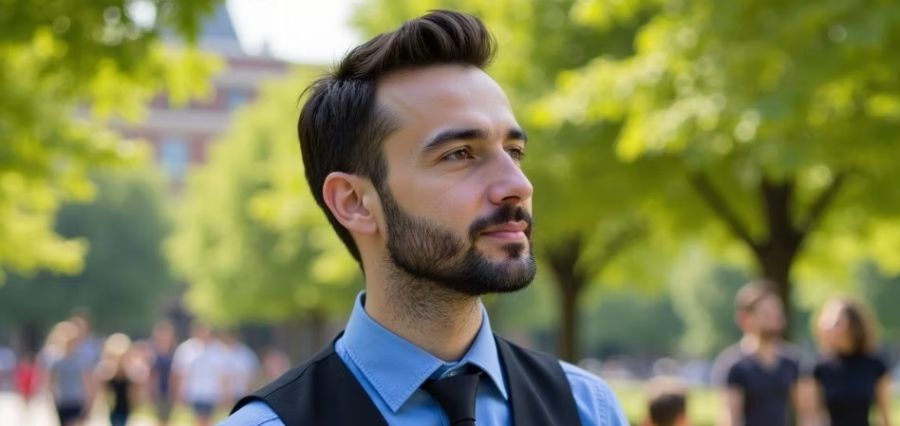Innovations in Advanced Technology and Education!
The field of advanced technology and education explores the intricate mechanics of systems and the profound impact of digital interfaces on their functionality. The integration of engineering principles with cutting-edge computer science brought forth groundbreaking advancements, shaping industries and challenging traditional norms. At its core, this industry thrives on the synergy between theoretical knowledge and practical application, driving continuous discovery.
Leading this transformation is Michael Short, serving as a Professor of Control Engineering and Systems Informatics at Teesside University. With a rich academic background and extensive industry experience, he has garnered acclaim for his innovative research and influential contributions. His role as Professor personifies a commitment to academic excellence and innovation, nurturing a generation of forward-thinking professionals poised to redefine technological frontiers.
Teesside University, which has UK campuses in Middlesbrough and London, is a beacon of academic excellence and technological advancement. Known for its progressive approach to education and research, the university has established itself as a hub for nurturing talent and driving industry collaboration. Through strategic initiatives and a dedicated focus on digital integration, the University continues to empower students and researchers alike, ensuring they are equipped to tackle the challenges of tomorrow with confidence.
Let’s explore the impactful journey of Michael:
Could you share a bit about your early life and what inspired you to pursue a career in Control Engineering and Systems Informatics?
As a child I was always inquisitive about how things like engines worked and was always asking questions – some of which my parents realized they couldn’t always answer. I became fascinated with Lego, especially the technical kits that interfaced with computers -which at the time was a ZX Spectrum. It made sense to move into a career in Engineering, and after serving an apprenticeship in control and instrumentation after leaving school, I studied for a part-time degree and then a PhD in Robotics. It has always been the boundaries between engineering and computer science, subjects like digital control, embedded systems and industrial informatics, which interest me most. I’ve been blessed to be able to teach and carry out research in these areas for over twenty years now.
What do you find most fulfilling about your work, and what continues to drive your passion for this field?
Research has always been my driving passion: to see an idea brought through creation, development, experimentation, analysis and publication in a high-impact journal is an exciting and very rewarding process. Additional aspects of innovation and enterprise are also very rewarding – seeing research ideas incorporated into new products and services is very satisfying. All are extremely hard work.
I also enjoy teaching aspects of my role, especially the ‘lightbulb’ moments. A really rewarding situation is when research, teaching and industrial engagement can be aligned. It is highly satisfying to be teaching knowledge you have created and published, like new control design methods and using examples to show how they have been applied in real-world situations in industry. Often, not all aspects cannot always be brought together, but when they can, it is the sweet spot and high motivation for students. Over time, as my research portfolio has grown, the nature of my role has also changed – a stronger focus now must be placed upon mentoring, leadership and management of people and projects. I can still be found in the lab and presenting work at conferences, but overall, I can’t win if my team doesn’t also win! I am continuously learning and trying to grow, and this has kept me motivated over the years – and I hope it will continue to do so going forwards.
Can you highlight some key milestones in your professional career and how they have influenced your current role at Teesside University?
My career began with a technical apprenticeship at 16 and completing it at 20, followed by earning a Bachelor’s degree in Electrical and Electronic Engineering at 24. These experiences provided me with essential practical and theoretical foundations. Initially an average student, the apprenticeship allowed me to engage in technical industry while studying at a local college, sparking my academic success. Moving into full-time academic studies, I obtained a Doctorate in Robotics and AI at 28, a significant milestone in my family. Publishing my research and securing grant funding marked important achievements, demonstrating my capability in scientific circles. Becoming a full professor in 2020 was a crowning achievement while being recognized as one of the top ten influencers on Net Zero in the UK was a recent milestone. These accomplishments have shaped my character and contributed to my role at Teesside University.
What is your teaching philosophy and how do you ensure your students are engaged and motivated?
I was, and still am, interested not only in how things work but also in why we build and operate them. For me, the ‘why’ is vital in teaching STEM subjects, especially where deep math or analysis is involved: it keeps the inquisitive mind motivated, and at higher levels, it also helps to frame our research questions, justify our funding applications, and drive our analytical creativity. My teaching philosophy is largely based upon problem-driven development: start by explaining ‘the why’: why we are going to look at a particular topic: by giving a motivating example drawn from industry, perhaps. This identifies a problem in a context which learners should be familiar with. Then, explain ‘the how’: how a solution is going to be crafted to solve the problem, what theory (e.g., physics and math) will be used and how it will be applied. Finally, cover ‘the what’: what is the solution (in the context of a real-world problem). It can be applied equally well to fundamental theory (why use the Laplace Transform? To solve complicated equations in linear calculus using algebra and an integral transform to compress linear signals, how to apply the transform and what examples look like in the context of real linear signals) through to applications (why use a speed governor? To regulate the speed of machines connected to a steam turbine, how we can apply dynamics and algebra to obtain and fine-tune models of mechanical and thermal components and connections and what it looks like when implemented in a practical ball-governor). Overall, I find that this problem-based learning approach works well – and keeping deep technical sessions to around 30 minutes between breaks also keeps minds fresh. Putting deep technical materials into smaller online lectures is also a good idea to keep the focus in the session on why it’s being applied, with deep derivations, proofs and analysis kept for self-learning.
How do you think the education system, particularly in engineering, needs to evolve to better prepare students for future challenges?
Traditionally, engineering is seen as a hard subject to study at degree and post-degree level, there is little doubt about it. The heavy, formal requirements around applied physics and math can indeed be challenging, especially for those coming from pre-degree pathways which may focus more upon vocational aspects within the disciplines. Both skill sets are clearly important, but the former comes more sharply into focus in HE. Problem-based learning seems particularly effective in these situations.
How do you see artificial intelligence and machine learning impacting the field of Control Engineering and Systems Informatics?
Digital control systems and artificial intelligence (AI) exhibit significant parallels and intersections. Control engineering involves designing and optimizing systems that regulate other devices, while AI focuses on enabling machines to perceive environments and make intelligent decisions to achieve goals. When digital control systems are implemented, they use sensors to perceive and actuators to regulate environments, akin to AI systems. Informatics, data science and machine learning play crucial roles, particularly in system identification with empirical models like ARMA or ANN and in advanced digital control such as adaptive learning and optimization with MARL and MPC. Despite these techniques’ historical roots, recent advancements in IoT, embedded systems, cloud computing, and algorithm design have made practical implementations feasible across various industries, suggesting continued growth in this integration.
What role do you think engineers and researchers have in influencing public policy and decision-making on technological issues?
In any democratic society, individuals are entitled to their opinions, and governance reflects the majority will of the public. However, not every decision can or should be left to a public referendum. Elected representatives are entrusted to make decisions and formulate policies on behalf of their constituents. It is logical for these representatives to seek guidance from qualified experts when shaping policy, including engineers and scientists for technological matters, alongside economists and union representatives. While public input is valued in elections, elected officials should prioritize trusted and reliable expert opinions when formulating policies in areas such as transportation, education, technology and entertainment regulation. Acknowledging imperfections in politics, the integration of expert advice into policy-making by elected representatives is likely to yield balanced outcomes.
What are your hopes for the future of Teesside University and its role in shaping the next generation of engineers and researchers? How do you hope to inspire the next generation of engineers and researchers through your work?
Since around 2016, Teesside University has started a period of transformation change, with digital technologies for learning, teaching, research and enterprise at its heart. We have set a future-facing learning strategy, structured our digital offer and made sure that digital technologies and data science underpin all relevant course offerings. All our undergraduate students are given a new iPad when starting our full-time courses to enable equitable technology access. We were the first UK University to fully join Siemens connected curriculum to ensure engineering graduates are both digital natives and industry-ready. In my own school – computing, engineering and digital technologies – we have re-structured our research and innovation activities to better align with the current direction of travel. We created two research centers (sustainable engineering and digital innovation) and have opened two innovation centers (net zero and manufacturing digitalization). We have also opened research centers in bioinformatics, healthcare and others. Our industrial engagement is strong regionally, nationally and internationally and enables us to offer placements and internships with SMEs and larger industries. I hope to inspire the next generation through my own teaching, industrial engagement and research outputs – in ways that are inclusive and allow them to participate, as well.



















